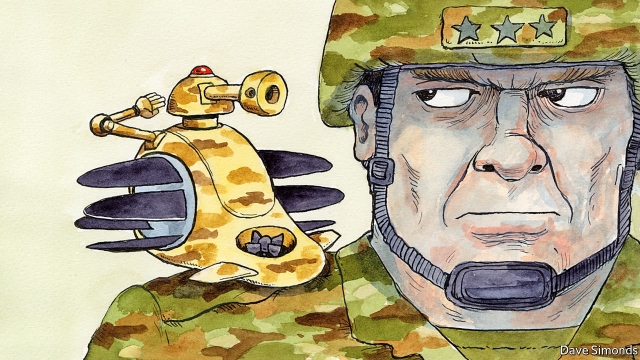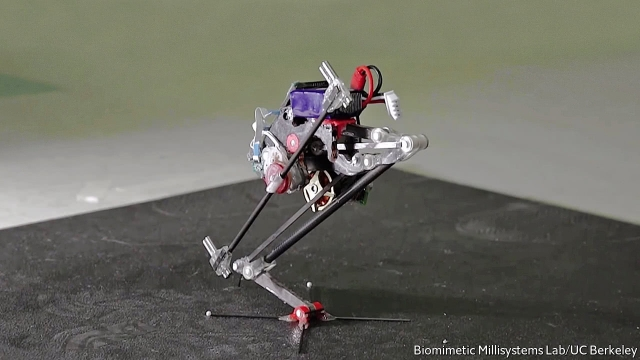 On November 12th a video called “Slaughterbots” was uploaded to YouTube. It is the brainchild of Stuart Russell, a professor of artificial intelligence at the University of California, Berkeley, and was paid for by the Future of Life Institute (FLI), a group of concerned scientists and technologists that includes Elon Musk, Stephen Hawking and Martin Rees, Britain’s Astronomer Royal. It is set in a near-future in which small drones fitted with face-recognition systems and shaped explosive charges can be programmed to seek out and kill known individuals or classes of individuals (those wearing a particular uniform, for example). In one scene, the drones are shown collaborating with each other to gain entrance to a building. One acts as a petard, blasting through a wall to grant access to the others.
On November 12th a video called “Slaughterbots” was uploaded to YouTube. It is the brainchild of Stuart Russell, a professor of artificial intelligence at the University of California, Berkeley, and was paid for by the Future of Life Institute (FLI), a group of concerned scientists and technologists that includes Elon Musk, Stephen Hawking and Martin Rees, Britain’s Astronomer Royal. It is set in a near-future in which small drones fitted with face-recognition systems and shaped explosive charges can be programmed to seek out and kill known individuals or classes of individuals (those wearing a particular uniform, for example). In one scene, the drones are shown collaborating with each other to gain entrance to a building. One acts as a petard, blasting through a wall to grant access to the others.
“Slaughterbots” is fiction. The question Dr Russell poses is, “how long will it remain so?” For military laboratories around the planet are busy developing small, autonomous robots for use in warfare, both conventional and unconventional. In America, in particular, a programme called MAST (Micro Autonomous Systems and Technology), which has been run by the US Army Research Laboratory in Maryland, is wrapping up this month [December 2017] after ten successful years. MAST co-ordinated and paid for research by a consortium of established laboratories, notably at the University of Maryland, Texas A&M University and Berkeley (the work at Berkeley is unrelated to Dr Russell’s). Its successor, the Distributed and Collaborative Intelligent Systems and Technology (DCIST) programme, which began earlier this year, is now getting into its stride.
In 2008, when MAST began, a spy drone that you could hold in the palm of your hand was an idea from science fiction. Such drones are now commonplace. Along with flying drones, MAST’s researchers have been developing pocket-sized battlefield scouts that can hop or crawl ahead of soldiers. DCIST’s purpose is to take these autonomous robots and make them co-operate. The result, if the project succeeds, will be swarms of devices that can take co-ordinated action to achieve a joint goal.
A hop, skip and jump away
At the moment, America’s defence department is committed to keeping such swarms under human control, so that the decision to pull a trigger will always be taken by a person rather than a machine. The Pentagon is as alarmed by the prospect of freebooting killer robots as the FLI is. But, as someone said of nuclear weapons after the first one was detonated, the only secret worth keeping is now out: the damn things work. If swarms of small robots can be made to collaborate autonomously, someone, somewhere will do it.
Existing small drones are usually polycopters — helicopters that have a set of rotors (generally four or six) arranged at the vertices of a regular polygon, rather than a single one above their centre of gravity. Some MAST researchers, however, think they have alighted on something better.
Their proposed replacement is the cyclocopter. This resembles an airborne paddle steamer. Though the idea of cyclocopters has been around for a while, the strong, lightweight materials needed to make them have hitherto been unavailable and the computing tools needed to design them have only recently been created. Now that those materials and tools do exist, things are advancing rapidly. Over the course of the MAST project the researchers have shrunk cyclocopters from being behemoths weighing half a kilogram to svelte devices that tip the scales at less than 30 grams. Such machines can outperform polycopters.
Cyclocopter aerodynamics is more like that of insects than of conventional aircraft, in that lift is generated by stirring the air into vortices rather than relying on its flow over aerofoils. For small cyclocopters this helps. Vortex effects become proportionately more powerful as an aircraft shrinks, but, in the case of conventional craft, including polycopters, that makes things worse, by decreasing stability. Cyclocopters get better as they get smaller.
They are also quieter. As Moble Benedict of Texas A&M, one of the leaders of the cyclocopter project, observes, “aerodynamic noise is a strong function of the blade-tip speed” — hence the whup-whup-whup of helicopters. The blade-tip speeds of cyclocopters are much lower. That makes them ideal for spying. They also have better manoeuvrability, and are less disturbed by gusts of wind.
Dr Benedict reckons cyclocopters are about two years away from commercial production. Once that happens they could displace polycopters in many roles, not just military ones. But they are not the only novel technology in which MAST has been involved. The programme has also worked on robots that hop.
 One of the most advanced is Salto, developed by the Biomimetic Millisystems Laboratory at the University of California, Berkeley. Salto (pictured) is a monopod weighing 98 grams that has a rotating tail and side-thrusters. These let it stabilise itself and reorient in mid-leap. That gives it the agility to bounce over uneven surfaces and also to climb staircases.
One of the most advanced is Salto, developed by the Biomimetic Millisystems Laboratory at the University of California, Berkeley. Salto (pictured) is a monopod weighing 98 grams that has a rotating tail and side-thrusters. These let it stabilise itself and reorient in mid-leap. That gives it the agility to bounce over uneven surfaces and also to climb staircases.
Salto’s speed (almost two metres a second) puts huge demands on its single leg. Ron Fearing, one of the electrical engineers developing it, puts things thus: “imagine a cheetah running at top speed using only one leg, and then cut the amount of time that leg spends on the ground in half.” As with cyclocopters, the materials and processing power needed to do this have only recently come into existence.
Dr Fearing says Salto and its kin are quieter than aerial drones and can operate in confined spaces where flying robots would be disturbed by turbulence reflected from the walls. They can also travel over terrain, such as collapsed buildings, that is off-limits to wheeled vehicles. Salto still needs work. In particular, it needs to be able to cling more effectively to what it lands on. Dr Fearing uses the analogy of a squirrel leaping from branch to branch. Arriving at the next branch is only half the battle. The other half is staying there. Once that is solved, though, which it should be in the next year or two, small non-flying robots that can go where their wheeled, or even track-laying, brethren cannot should become available for practical use.
Bouncing over the rubble of a collapsed building is not the only way to explore it. Another is to weave through the spaces between the debris. Researchers at the Biomimetic Millisystems lab are working on that, too. Their solution resembles a cockroach. Its body is broad and flat, which gives it stability but also permits it to crawl through narrow spaces — if necessary by going up on one side. Should it tip over whilst attempting this, it has wing-like extensions it can use to flip itself upright again.
Getting into a building, whether collapsed or intact, is one thing. Navigating around it without human assistance is quite another. For this purpose MAST has been feeding its results to the Defence Advanced Research Projects Agency (DARPA), America’s main federal military-research organisation. According to Brett Piekarski, who led MAST and is now in charge of DCIST, the Fast Lightweight Autonomy (FLA) programme at DARPA will continue MAST’s work with the aim of developing small drones that can “ingress and egress into buildings and navigate within those buildings at high speeds”. Some of that has already been done. In June DARPA reported that polycopters souped up by the FLA programme were able to slalom through woodlands, swerve around obstacles in a hangar and report back to their starting-point, all by themselves.
Unity is strength
The next challenge — the one that people like Dr Russell particularly worry about — is getting the robots to swarm and co-ordinate their behaviour effectively. Under the aegis of MAST, a group from the General Robotics, Automation, Sensing & Perception (GRASP) laboratory at the University of Pennsylvania did indeed manage to make drones fly together in co-ordinated formations without hitting each other. They look good when doing so — but, to some extent, what is seen is an illusion. The drones are not, as members of a swarm of bees or a flock of birds would be, relying on sensory information they have gathered themselves. Instead, GRASP’s drone swarms employ ground-based sensors to track individual drones around, and a central controller to stop them colliding.
That is starting to change. A farewell demonstration by MAST, in August, showed three robots (two on the ground and one in the air) keeping station with each other using only hardware that was on board the robots themselves. This opens the way for larger flocks of robots to co-ordinate without outside intervention.
Moreover, as that demonstration showed, when drones and other robots can routinely flock together in this way, they will not necessarily be birds of a feather. “Heterogeneous group control” is a new discipline that aims to tackle the thorny problem of managing units that consist of various robots — some as small as a postage stamp, others as large as a jeep — as well as human team members. Swarms will also need to be able to break up into sub-units to search a building and then recombine once they have done so, all in a hostile environment.
Such things are the goals of DCIST. The first tranche of grants to these ends, some $27m of them, has already been awarded to the University of Pennsylvania, the Massachusetts Institute of Technology, the Georgia Institute of Technology and the University of California, Berkeley. When DCIST itself wraps up, probably in 2022, the idea of Slaughterbots may seem a lot less fictional than it does now.
No comments:
Post a Comment